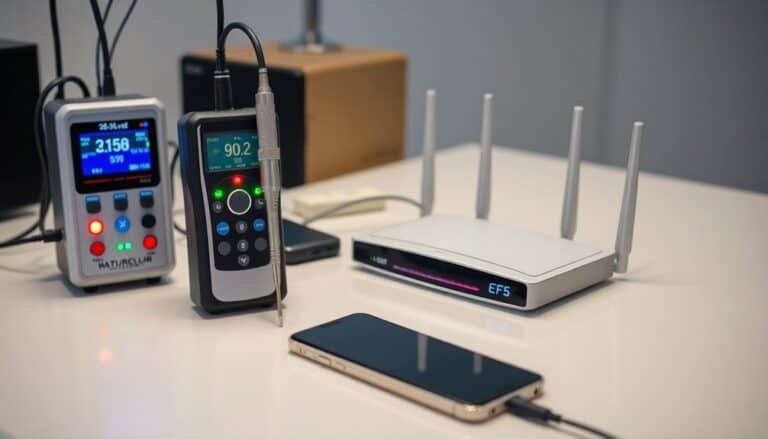Safe Distance Guidelines for Common EMF Sources
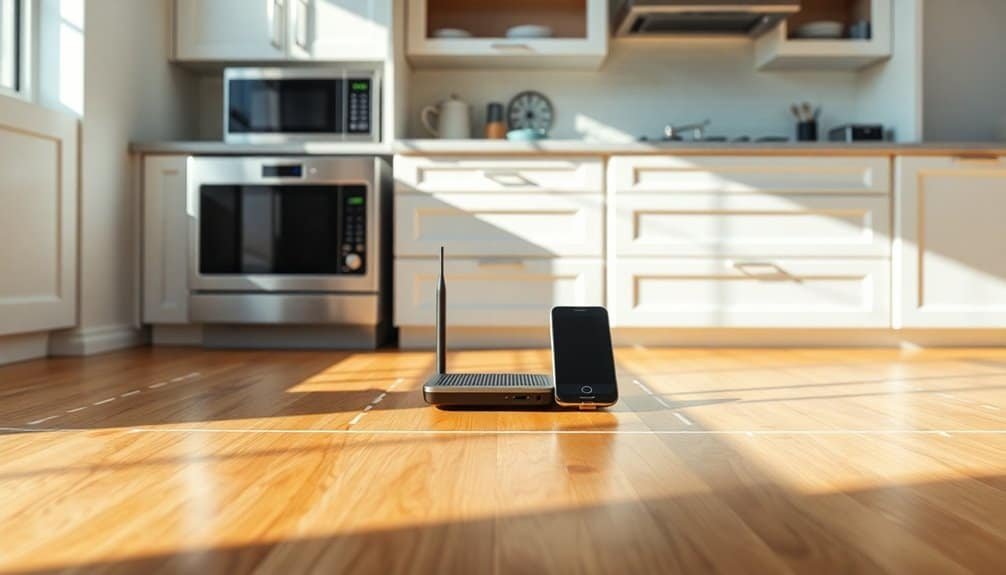
Maintain a distance of at least 700 feet from power lines and keep mobile devices 8 to 10 inches away, ideally 2 to 5 feet, to minimize EMF exposure. During microwave use, stay 4 feet away and use low-EMF appliances to create a safer living environment.
Regularly monitor EMF levels in your home to protect your health and gain more insights into reducing exposure. Understanding these guidelines can help ensure a safer, healthier living space.
Disclaimer: As an affiliate, I may collect a share of sales from the links on this page.
Understanding EMF and Its Sources
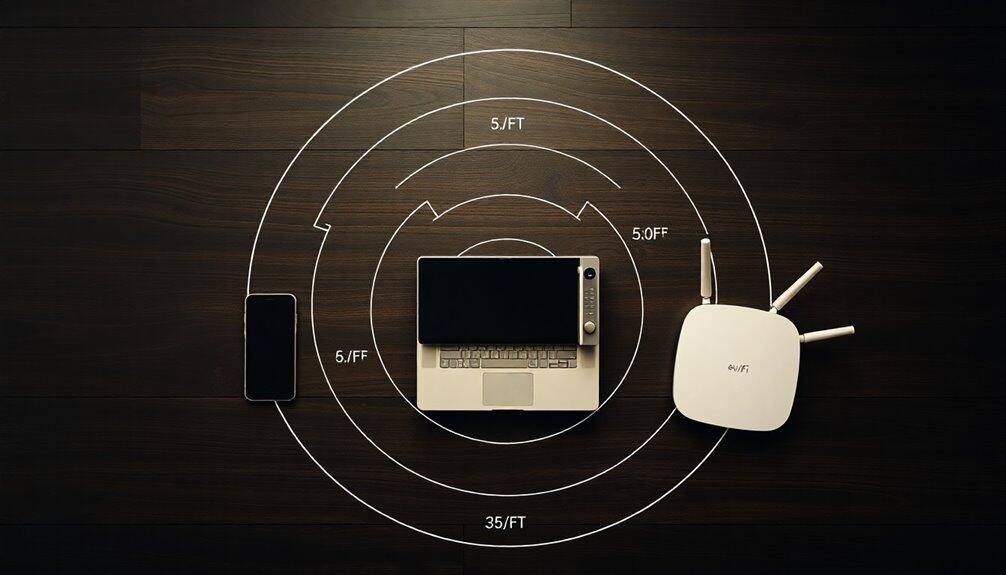
Electromagnetic fields (EMFs) play an essential role in modern technology and natural processes. These fields consist of electric and magnetic components, linked to electrical power and various radiation forms. EMFs are part of the electromagnetic spectrum, which includes radio waves, microwaves, and visible light. They can be classified as ionizing, which includes high-frequency radiation like X-rays, or non-ionizing, typically low-frequency and considered safer. Natural sources include sunlight and the Earth’s magnetic field, while man-made sources consist of appliances and mobile devices. Understanding these sources is vital for recognizing their potential effects on everyday life and health. The behavior of electric and magnetic fields can vary based on the observer’s motion relative to the sources, highlighting the complexity of our interaction with EMFs. Long-term exposure to EMFs from devices like microwaves and wireless communications has raised concerns over potential health effects, making awareness and precautionary measures essential.
Safe Distances From Power Lines
When considering safe distances from power lines, it’s essential to recognize how EMF intensity diminishes with increasing distance. A safety distance of at least 700 feet can help reduce exposure to below 0.5 milligauss, particularly near high voltage transmission lines. These lines emit stronger magnetic fields than neighborhood distribution lines. Use a gaussmeter to measure magnetic field strength, as this will help you determine your specific safe distance. Regular monitoring is vital for maintaining safe conditions and mitigating potential long-term health risks. Additionally, testing with a gaussmeter will provide a clearer understanding of the EMF levels in your environment for better safety assessments. Implementing measures such as emf shielding products can further enhance your protection from harmful radiation sources.
Minimizing Exposure to Mobile Devices
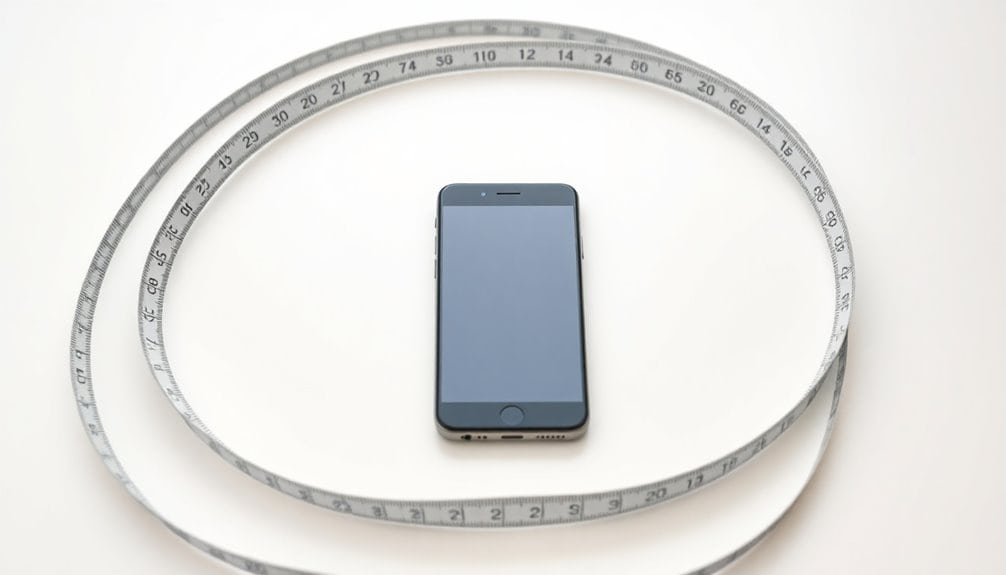
Minimizing exposure to mobile devices is essential for reducing potential health risks associated with radiofrequency (RF) radiation. Keep your mobile device at least 8″ to 10″ away, ideally 2′ to 5′ for ideal safety. Maintain a distance of 12″ from your face and eyes during use. It is important to consider the ICNIRP guidelines, which aim to protect humans from RF electromagnetic fields. Continuous exposure to wireless radiation can lead to health risks such as insomnia and fertility issues, making it crucial to take precautions. Utilize Airplane Mode to disable wireless communication, turning off Bluetooth and WiFi when unnecessary. Employ hands-free options like speakerphones or air-tube headphones, which can decrease direct contact with your body. Use phone leashes to guarantee adequate separation. Stay aware of your device’s placement to further limit EMF exposure, especially near other electronic devices.
Guidelines for Microwave Oven Safety
Microwave ovens are widely used appliances, providing quick and convenient meal preparation.
To guarantee safety, these ovens comply with strict FDA standards, limiting radiation emissions to 5 milliwatts per square centimeter at 2 inches. Equipped with two independent interlock systems, they halt operation when the door opens.
Always avoid metal objects inside, and adhere to the user manual for safe operation. Maintain at least a 122 cm distance during use to reduce EMF exposure.
Regular maintenance prevents leaks. Remember, power density decreases considerably with distance, making safe practices essential for your health when using microwave ovens.
Reducing EMF Risks in Living Spaces
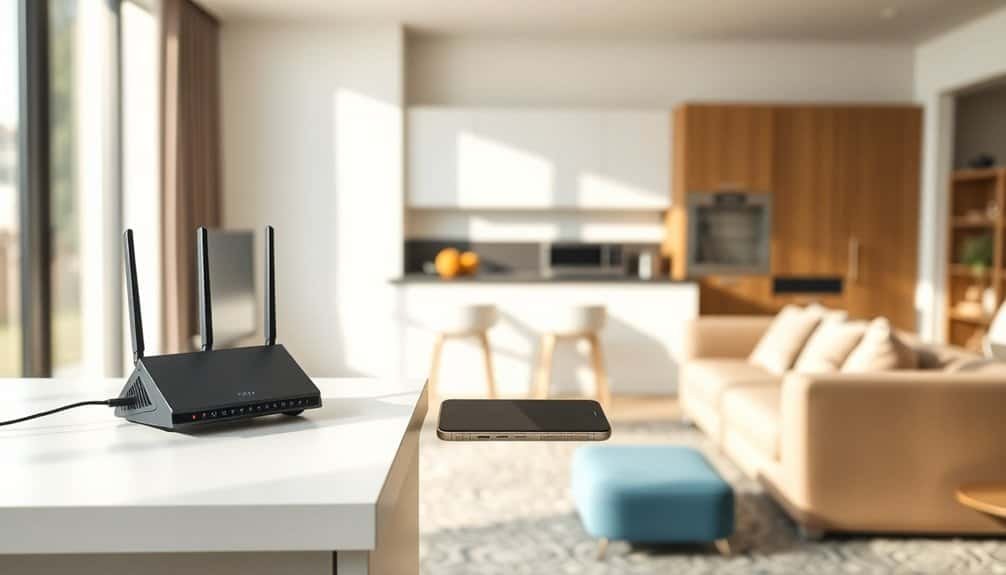
To effectively reduce electromagnetic field (EMF) exposure in your home, awareness and strategic practices are essential.
Start by identifying common sources, such as Wi-Fi routers and electrical appliances. Increase distance from these sources, as magnetic fields decrease rapidly with distance. Limit usage of high EMF devices, like hair dryers.
Regularly monitor EMF levels to identify high-risk areas. In sleeping spaces, aim for magnetic fields below 1-2 mG and keep beds away from EMF sources.
Choose low EMF appliances whenever possible. Implementing these practices can help create a safer living environment, reducing potential health risks associated with prolonged exposure.
Effective Shielding Techniques
Effective shielding techniques can greatly reduce EMF exposure from various sources, protecting both health and technology.
Material selection is essential; conductive and magnetic materials perform best. For maximum attenuation, choose thicker and larger shields. Keep in mind that shielding effectiveness varies with different frequencies.
Small apertures can compromise effectiveness, so make sure any openings are minimal. Use conductive enclosures, such as Faraday cages, along with EMI shielding gaskets to improve seals.
Magnetic shielding materials can effectively block magnetic fields, while cable shielding protects wires from external EMF.
Always measure attenuation in decibels to determine shielding performance accurately.
Establishing EMF-Free Zones
Establishing EMF-free zones requires careful planning and specific measures to minimize electromagnetic field exposure. These zones often feature strict regulations on electronic device usage, limiting sources such as cell phones and Wi-Fi routers.
You can categorize these zones into inner, outer, and coordination zones, each reflecting varying levels of EMF restrictions. Utilizing guidelines from organizations like ICNIRP helps in defining safe exposure limits.
Identifying natural settings or areas with legal restrictions is essential for these zones. Community engagement fosters compliance, while regular monitoring of EMF levels guarantees safety.
Ultimately, EMF-free zones support public health and environmental preservation.
Frequently Asked Questions
Are There Specific EMF Sources in My Home I Should Monitor?
You should monitor sources like cell phones, Wi-Fi routers, and microwaves. Keeping track of these devices’ emissions can help minimize your exposure and potentially improve your sleep quality and overall well-being. Stay informed!
How Often Should I Check for EMF Exposure in My Environment?
You’d be amazed how often your environment can change! Check for EMF exposure periodically, especially when new devices arrive, health issues arise, or usage patterns shift—regular monitoring guarantees you’re staying safe and informed.
Are Children More Vulnerable to EMF Exposure Than Adults?
Yes, children are more vulnerable to EMF exposure than adults due to thinner skulls, developing nervous systems, and longer cumulative exposure. Reducing screen time and using low EMF devices can help protect them.
What Should I Do if I Suspect My Appliances Are Leaking EMF?
If you suspect your appliances are leaking EMF, turn them off immediately. Inspect for wear and damage, use an EMF meter, and consult a professional for further evaluation to guarantee safety and reduce exposure.
Can I Measure EMF Levels Myself, and How?
Sure, you can channel your inner scientist! Grab an EMF meter, wave it over appliances like a magic wand, and watch those numbers dance. Just don’t expect a fanfare; it’s more about diligence than drama!
Conclusion
Adhering to safe distance guidelines significantly reduces electromagnetic field (EMF) exposure. For example, living beyond 300 meters of high-voltage power lines decreases radiation exposure by 30%.
Implementing shielding techniques and maintaining reasonable distances from EMF sources effectively minimizes health risks. Creating EMF-free zones further enhances safety.
Prioritizing these strategies supports a safer living environment. It fosters greater awareness of EMF influences in daily life.





